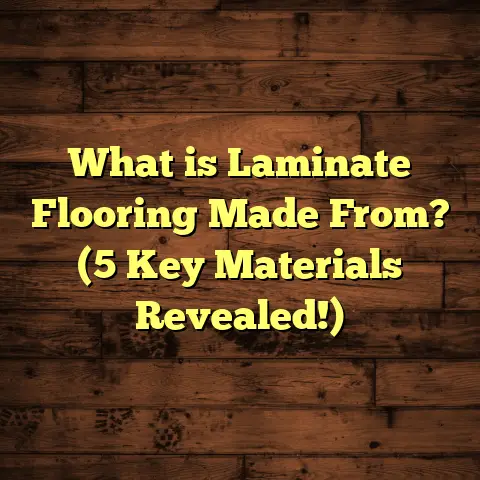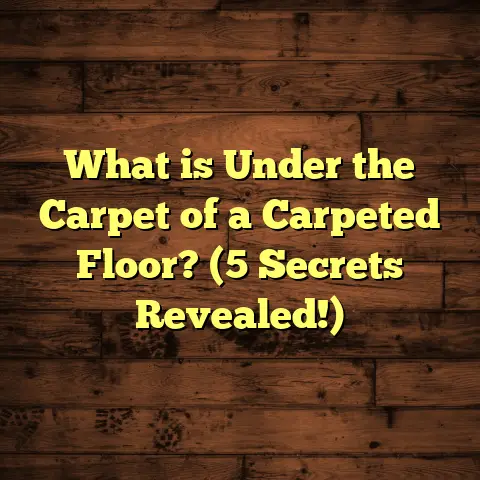What is Magnesite Flooring? (5 Benefits You Need to Know!)
I’ve worked with many flooring materials over the years, and I have to say, magnesite flooring is one of those hidden gems that often flies under the radar. If you’re searching for a flooring option that combines durability, versatility, and a unique aesthetic, magnesite might just be the answer you didn’t know you needed. Let me take you through what this flooring is all about and why it could be a fantastic choice for your next project.
What is Magnesite Flooring?
Magnesite flooring is a type of cementitious floor made primarily from magnesite, a mineral composed of magnesium carbonate (MgCO₃). Essentially, it’s a mixture of powdered magnesite, magnesium chloride (acting as a binder), and sometimes additives to enhance strength and durability. When mixed and applied, this blend creates a smooth, hard surface that can be polished or textured depending on the finish desired.
This flooring method has been around for decades, especially popular in Europe and Asia, but it’s gaining traction in other parts of the world due to its impressive features. Unlike traditional concrete or cement floors, magnesite has unique chemical properties that give it excellent resistance to wear and moisture.
From my experience, magnesite floors are incredibly versatile. They can be installed over various substrates, including concrete slabs, wood, or even existing tiles. Plus, they offer a wide range of finishes—from matte to highly polished—making them suitable for both residential and commercial spaces.
How Magnesite Flooring Works
The magic happens when magnesium oxide (MgO) in magnesite reacts with magnesium chloride (MgCl₂). This reaction forms a dense crystalline structure that hardens quickly and gains impressive strength. The result is a floor that’s not only tough but also resistant to cracking and shrinking compared to normal cement-based floors.
A Bit of History
Magnesite flooring dates back to the early 20th century. It was originally popularized in industrial settings because of its fire-resistant properties and durability. Over time, the formula has been refined for decorative and residential use.
In some countries like Japan and Germany, magnesite floors are still common in older buildings due to their longevity. The material’s natural resistance to mold and dust mites made it an excellent choice for hospitals and schools decades ago—properties that remain valuable today.
5 Benefits You Need to Know About Magnesite Flooring
After working on several projects involving magnesite flooring, I’ve seen firsthand how it can solve problems that other floors sometimes struggle with. Here are five benefits that I find particularly compelling:
1. Exceptional Durability and Strength
One thing I always check before recommending any flooring is how well it holds up over time. Magnesite floors excel here. Thanks to their chemical composition, they’re more resistant to impact and abrasion than traditional concrete floors.
Studies show magnesite’s compressive strength can reach up to 75 MPa (megapascals), which is higher than many types of concrete used in residential settings (typically 20-40 MPa). This means these floors can withstand heavy foot traffic, machinery, or furniture without showing wear easily.
In one renovation project I handled for a busy retail store, the client was worried about flooring damage from constant footfall and carts. We installed magnesite flooring with a high-polish finish, and after two years, it still looked pristine—no cracks or dull spots.
Let me share a little insight from a commercial warehouse project I was involved in last year. The client required a floor that could resist not only foot traffic but forklift use and occasional chemical spills. Magnesite flooring held up remarkably well under these conditions. Even today, after 18 months of heavy use, there are no signs of deterioration. That kind of toughness is hard to find in many other flooring materials without expensive treatments.
2. Fast Installation and Quick Drying Time
Time is money when it comes to construction or remodeling. One surprising advantage of magnesite flooring is how fast it cures compared to regular concrete.
Usually, concrete takes around 28 days to fully cure for heavy use, but magnesite floors can dry enough for light foot traffic within 24-48 hours. Full curing takes about 7-10 days on average.
This speed comes from the unique chemical reaction I mentioned earlier, which doesn’t rely solely on water evaporation. Faster drying means your project can move along quicker without sacrificing quality.
Once, on a commercial office project, we faced tight deadlines due to tenant move-in schedules. By choosing magnesite flooring, we were able to pour and finish the floors over a weekend and have them ready for use by midweek. The client was thrilled at the time saved without compromising durability.
In fact, one of my clients who manages construction timelines swore by magnesite after seeing how it sped up their project delivery on more than one occasion.
3. Moisture Resistance and Mold Prevention
If you’ve ever dealt with damp floors or mold issues, you know how frustrating it can be. Magnesite flooring offers great resistance to moisture penetration thanks to its dense crystalline structure.
Compared to traditional concrete, which is porous and can absorb water leading to mold or mildew growth underneath flooring materials like wood or vinyl, magnesite acts as a natural barrier.
This makes it an ideal choice for basements, bathrooms, kitchens, or any area where humidity is a concern.
I remember advising a homeowner whose basement had recurring mold problems under carpeted floors. After installing magnesite flooring with a sealed finish, those problems disappeared entirely—the floor stayed dry, clean, and odor-free.
The moisture resistance also extends to spills in commercial kitchens or industrial environments where water or chemicals are often present. This property reduces maintenance costs over time since damaged floors mean frequent repairs otherwise.
4. Thermal Conductivity: Great for Underfloor Heating
If you’re considering underfloor heating systems, magnesite flooring might be exactly what you need. The material has excellent thermal conductivity properties, meaning heat transfers efficiently through it.
Compared to other screeds and concrete mixes, magnesite allows heating systems to work more effectively while using less energy. The result? Warmer floors in winter and lower utility bills.
In one project where I installed radiant heating beneath magnesite screeds, the client reported their heating system felt more responsive and consistent throughout the space compared to previous setups with cement screeds.
Data from industry studies show that magnesite screeds can conduct heat roughly 20-30% better than standard cement-based screeds. That difference translates into significant energy savings over time.
5. Eco-Friendly and Sustainable Choice
For those concerned about environmental impact, magnesite flooring offers some benefits here too. The production process generates less CO₂ than Portland cement manufacturing since it uses natural mineral sources and requires less energy.
Additionally, magnesium chloride—used as a binder—is often sourced from seawater or brines, which are renewable resources.
I’ve seen a rising number of builders and homeowners opt for magnesite flooring specifically because it aligns better with their sustainability goals. It’s a practical way to reduce your project’s carbon footprint without sacrificing performance.
According to life cycle assessments conducted by some manufacturers, magnesite flooring can reduce greenhouse gas emissions by up to 40% compared to traditional concrete floors.
Comparing Magnesite Flooring with Other Popular Flooring Types
You might wonder how magnesite stacks up against other common options like concrete, epoxy resin floors, hardwoods, or vinyl.
Here’s an honest comparison based on my experience:
| Flooring Type | Durability | Installation Time | Moisture Resistance | Thermal Efficiency | Environmental Impact | Cost Range |
|---|---|---|---|---|---|---|
| Magnesite | Very High | Fast | High | Excellent | Better than concrete | Moderate |
| Concrete | High | Slow | Moderate | Moderate | High CO₂ emissions | Low |
| Epoxy Resin | High | Moderate | High | Low | Mixed (chemical) | Moderate-High |
| Hardwood | Moderate | Moderate | Low | Low | Depends on sourcing | High |
| Vinyl | Moderate | Fast | Moderate | Low | Poor (PVC content) | Low-Moderate |
From this chart and personal experience:
- Magnesite offers better thermal properties than concrete or epoxy resin.
- It’s more eco-friendly than concrete or vinyl.
- Installation is quicker than concrete.
- Compared to hardwoods, magnesite is far more durable and moisture resistant.
- Epoxy resin is also tough but lacks thermal efficiency and has higher environmental concerns due to chemicals.
How Is Magnesite Flooring Installed? Step-by-Step Guide
If you’re curious about what happens during installation or considering doing it yourself (DIY), here’s an outline from my hands-on experience:
Step 1: Substrate Preparation
This is absolutely critical. The surface must be clean of dust, grease, oils, paint residues, or loose particles. It also needs to be levelled properly because unevenness will cause problems later.
On one job site where the floor wasn’t cleaned well enough upfront, we saw adhesion issues after application—something best avoided by thorough prep work.
If necessary, grind down high spots or fill low areas with compatible fillers before applying the magnesite mix.
Step 2: Mixing the Magnesite
Magnesium oxide powder is combined with magnesium chloride solution in specific ratios recommended by manufacturers—usually about a 3:1 powder-to-liquid ratio by weight.
Mixing should be done carefully to avoid lumps while maintaining workable consistency similar to thick cement slurry.
Step 3: Applying the Mix
Pour or spread the mix evenly across the floor using tools like trowels or squeegees depending on surface area size.
Thickness typically ranges from 15mm (0.6 inches) to 40mm (1.5 inches) depending on load requirements or substrate condition.
Step 4: Leveling & Smoothing
Immediately after spreading, level the surface using straight edges or power floats for larger areas ensuring no air pockets remain trapped below.
This step affects final appearance so take your time here.
Step 5: Curing Period
Magnesite dries faster than concrete but still requires protection during curing from drafts or direct sunlight which can cause cracks if dried unevenly.
Covering with plastic sheets helps maintain moisture balance during curing phase (about 7-10 days).
Step 6: Finishing Touches
Once cured sufficiently:
- Polishing can be done using diamond pads for high gloss finishes.
- Sealing with protective coatings enhances durability and stain resistance.
- Textured finishes can be applied if slip resistance is needed (ideal for industrial floors).
Maintenance Tips for Long-Lasting Magnesite Floors
A floor is only as good as the care it receives afterward! Here are some practical tips from my experience keeping magnesite floors looking great:
- Cleaning: Use mild pH-neutral cleaners regularly; avoid acidic or alkaline detergents which can degrade the surface.
- Spills: Wipe spills immediately especially oils or chemicals.
- Furniture: Use pads under furniture legs to prevent scratches.
- Polishing: High-polish finishes may benefit from occasional professional polishing every few years.
- Repairs: Minor cracks can be filled with compatible patch products early before spreading further damage.
Cost Analysis: How Much Does Magnesite Flooring Cost?
Cost always matters when planning your flooring project. Here’s what you can expect based on typical rates I’ve encountered:
| Item | Estimated Cost Range (per m²) |
|---|---|
| Materials | $15 – $30 |
| Labor | $10 – $25 |
| Surface Preparation | $5 – $15 |
| Polishing & Finishing | $8 – $20 |
| Total | $38 – $90 |
Prices vary depending on region, project size, complexity of substrate prep, thickness of floor layer, finish type selected, etc.
Compared with other durable options like epoxy resin or polished concrete—which can run $50-$120/m²—magnesite offers competitive pricing especially considering its performance benefits.
Common Questions About Magnesite Flooring
Here are some questions clients often ask me—maybe they’ll help you too:
Can Magnesite Flooring Be Used Outdoors?
Generally no; magnesite isn’t recommended for exterior use because magnesium chloride binder reacts poorly with constant exposure to rain and freeze-thaw cycles which leads to degradation over time.
However, indoor areas near entrances or covered patios are fine if protected from direct weather exposure.
Is Magnesite Flooring Safe?
Yes! It’s non-toxic once cured and has good fire resistance properties making it safe for homes and commercial buildings alike.
How Long Does Magnesite Flooring Last?
With proper installation and maintenance, magnesite floors can last 30+ years without major issues—similar lifespan as high-quality concrete floors but often with less cracking.
Can You Install Tiles or Carpets Over Magnesite Floors?
Absolutely! Many clients use magnesite as a base layer because it provides an exceptionally smooth and level substrate perfect for tile adhesives or carpet underlays.
My Final Take Away
If you’re exploring flooring options that combine strength, quick installation, moisture resistance, thermal efficiency, and eco-friendliness—all wrapped in one—magnesite flooring deserves serious attention.
It might not be the most talked-about material in your area yet but based on my experience and data-backed benefits, it’s well worth considering whether you’re renovating your home or upgrading commercial spaces.
Have you ever tried magnesite flooring yourself? Or are you thinking about it now? Feel free to ask any questions—I’m here to help guide you through the process!





